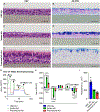Air-Liquid interface cultures to model drug delivery through the mucociliary epithelial barrier
- PMID: 37196698
- PMCID: PMC10336980
- DOI: 10.1016/j.addr.2023.114866
Air-Liquid interface cultures to model drug delivery through the mucociliary epithelial barrier
Abstract
Epithelial cells from mucociliary portions of the airways can be readily grown and expanded in vitro. When grown on a porous membrane at an air-liquid interface (ALI) the cells form a confluent, electrically resistive barrier separating the apical and basolateral compartments. ALI cultures replicate key morphological, molecular and functional features of the in vivo epithelium, including mucus secretion and mucociliary transport. Apical secretions contain secreted gel-forming mucins, shed cell-associated tethered mucins, and hundreds of additional molecules involved in host defense and homeostasis. The respiratory epithelial cell ALI model is a time-proven workhorse that has been employed in various studies elucidating the structure and function of the mucociliary apparatus and disease pathogenesis. It serves as a critical milestone test for small molecule and genetic therapies targeting airway diseases. To fully exploit the potential of this important tool, numerous technical variables must be thoughtfully considered and carefully executed.
Copyright © 2023 Elsevier B.V. All rights reserved.
Conflict of interest statement
Declaration of Competing Interest The authors declare that they have no known competing financial interests or personal relationships that could have appeared to influence the work reported in this paper.
Figures




References
-
- World Health Organization, Global Health Estimates: Life expectancy and leading causes of death and disability, The Global Health Observatory, World Health Organization, 2019. https://www.who.int/data/gho/data/themes/mortality-and-global-health-est... (accessed Aug. 26, 2022).
-
- Frisch AW, Jentoft V, Barger R, Losli EJ, A human epithelium-like cell (maben) derived from an adenocarcinoma of lung; isolation, continuous propagation, and effects of selected viruses, Am. J. Clin. Pathol, 25 (1955) 1107–1112. - PubMed
-
- Hoch-Ligeti C, Hobbs JP, Behavior of explants from human adult bronchial epithelium in vitro, Proc. Soc. Exp. Biol. Med, 97 (1958) 59–62. - PubMed
-
- Lechner JF, LaVeck MA, A serum-free method for culturing normal human bronchial epithelial cells at clonal density, J. Tissue Cult. Methods, 9 (1985) 43–48.
-
- Wu R, Yankaskas J, Cheng E, Knowles MR, Boucher R, Growth and differentiation of human nasal epithelial cells in culture. Serum-free, hormone-supplemented medium and proteoglycan synthesis, Am. Rev. Respir. Dis, 132 (1985) 311–320. - PubMed
Publication types
MeSH terms
Substances
Grants and funding
LinkOut - more resources
Full Text Sources

